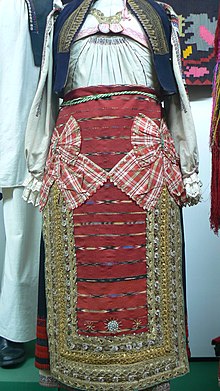Banat Bulgarian
The Banat Bulgarian is a South Slavic micro literary language that the historical Banat (W Romania , NO Serbia ) of approximately 20,000 Banat Bulgarians is spoken.
origin
A group of predominantly Catholic Bulgarians fled to the Banat in the 18th century after the failed uprising of Tschiprowzi against the Ottomans. Its south-west Bulgarian dialect gradually became a microliterature language due to the spatial and political separation from standard Bulgarian .
Quirks
Apart from the phonetic and morphological peculiarities, Banat Bulgarian also has fewer loanwords from Russian, Old Church Slavonic and Turkish than standard Bulgarian . But it contains more loan words from Serbian, Romanian, Hungarian and German (e.g. hajzenban for "railway").
font
The majority of the Banat Bulgarians are Roman Catholics and therefore use the Latin alphabet . In contrast, the standard Bulgarian used in the predominantly Orthodox Bulgaria is written in Cyrillic.
development
In the Austro-Hungarian monarchy , Banat Bulgarian was allowed to be taught in schools from the 1860s onwards, but it was ousted from everyday school life in the 1890s by the Magyarization and replaced by Hungarian. From 1930 the use of Banat Bulgarian was encouraged again in the Romanian part of the Banat, at least in the ecclesiastical and cultural areas. Bulgarian has been taught in schools since the Second World War - but standard Bulgarian. The Banat Bulgarian was thus limited to the ecclesiastical and private sphere. Since the early 1990s, the language has experienced an upswing thanks to the renewed self-confidence of the Banat Bulgarians.
Current distribution
Romania: Banat Bulgarian is the main language in the villages of Besenova Veche ( Dudeştii Vechi ), Breştea and Vinga . In Timișoara , the Banat Bulgarians are only a minority, but this city has replaced Vinga as the cultural center of the Banat Bulgarians.
Estimates of speakers of Banat Bulgarian in Serbia amount to around 5,000 who live as a minority in some communities in western Vojvodina (e.g. in Ivanovo ).
Use in the media
Radio Timișoara reports half an hour a week in Banat Bulgarian.
literature
In 1866 the first Banat-Bulgarian orthography, worked out by a teacher from Vinga, Jozu Rill, appeared: Bâlgàrskutu právupísanji .
In 2017, the translation of The Little Prince into Banat Bulgarian appeared in Timișoara: Manenija Princ. Sas svetičtata na pisátela na Léon Werth (translation by Ana-Maria Bodor Calapiș, Eurostampa, Commission Vanishing Languages and Cultural Heritage).
Web links
- Uni-Klu.ac.at (PDF; 191 kB), University of Klagenfurt , Aleksandr Duličenko: Banater Bulgarisch
Individual evidence
- ^ Austrian Academy of Sciences: Commission Vanishing Languages and Cultural Heritage. Retrieved September 14, 2018 .

